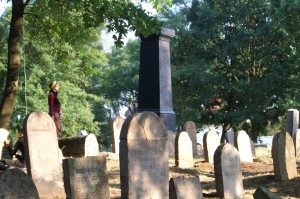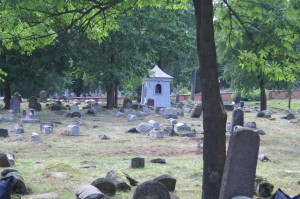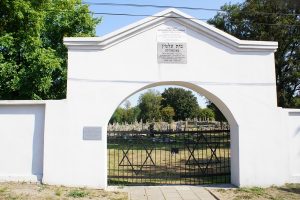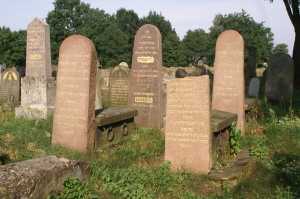Bagnowka Cemetery
About Bagnowka
Establishment:
In the district known as Bagnowka, in present-day Bialystok, Poland, three cemeteries lie adjacent to one another: cmentarz rzymsko-katolicki, cmentarz prawosławny and cmentarz żydowski, the Catholic, Orthodox and Jewish cemeteries, respectively. Nearby also stands cmentarz ewangelicki (the Protestant Cemetery) and cmentarze miejski (the City Cemetery). Bagnowka Beth Olam was the last cemetery to be established in this area in late 1891. The first official burial was of “the important, God-fearing woman, the married Fruma daughter of Reb Yehuda Leib. She died on and was buried on Monday 2 Tevet year 5652 [21 December 1891] – the same day the cemetery was officially dedicated. Today, the oldest extant matzevah is that of “Yehiel Michal, son of Bentsion.” He died on 25 Tevet 5651 [24 December 1890] – just three days short of one year BEFORE this cemetery was officially dedicated. This tombstone suggests that burials did occur before the official dedication of this cemetery. While the last recorded burial was in 1969, today the most recent matzevoth mark gravesites with dates of death in 1951 and 1952.
Bagnowka Jewish Cemetery was not the first or only cemetery that served Bialystok since it was granted town status in 1692. From the late 17th century to the aftermath of the Holocaust, possibly five other cemeteries within Bialystok, as well as Beth-Kevurim “burial grounds” outside Bialystok, were used to bury the Jewish dead of Bialystok. Documentation hints at the existence of a late 16th century cemetery in Bialystok’s Kosciusko Market; a poor house cemetery pre-1781; as well as more substantial documentation for the Old (Rabbinic) Jewish cemetery, established between 1774 and 1781 on Kalinowskiego Street in the Suraz suburb of Bialystok. A cholera cemetery was established in 1840 on Bema Street; and a Ghetto cemetery on Zabia Street was established during the Holocaust. (Map: http://kehilalinks.jewishgen.org/bialygen/bialcem.htm)
Name, Size and Burial Patterns
Called the New Beth Olam “house of the living” by Jewish historian Avraham Shmuel Herszberg (1860-1943), this cemetery also was called Bagnowka after what was previously a small town with deforested acres well-suited for a cemetery. Over the next 50 years, in its one hundred nearly uniform sections, it had the potential to cradle the bodies of 30-35,000 of Bialystok’s Jews. In reality, c. 12-15,000 burials occurred on the cemetery due to the near annihilation of the Bialystok Jewish community during WWII and the Holocaust. Surrounded by a brick plastered wall, it had one to two entrances on Wschodnia Street, another on its western border on Cemetery Street (no longer extant) and another entrance on its eastern border. In current times, this cemetery is also designated as the Wschodnia Street Cemetery.
In Bagnowka Beth-Olam, the practice of burying the priests and Levites nearest the entrances to preserve ritual purity seems to be maintained from 1892 until 1910, after which burial of one of priestly or Levite descent can be found throughout the cemetery, including the sections farthest from its three entrances and adjoining the Catholic cemetery. While men, women and children are buried within the same sections, each section does distinguish rows for men and rows for women. Children are buried at the back of a section, both boys and girls, at times, alongside women. Rabbis, scholars, merchants, men who “toil with their hands”, women of distinguished lineages, modest wives, mothers, and daughters; the aged, those in the prime of their life, and the very young are thus buried within the same section, a somewhat radical departure from earlier rabbinic practices, which necessitated these individuals be buried apart. These ‘modern’ practices suggest Bagnowka cemetery was impacted by assimilationist burial practices that began in the late 19th century. Such assimilationist practices also allowed an individual or the deceased’s family to determine the language and content of an epitaph and the style of a tombstone. Thus epitaphs are extant in Hebrew, Yiddish, Polish, Russian and German. Many are bilingual. In Bagnowka, family members are rarely buried in the same section; expansion of the cemetery necessitating the use of new sections was determined by the passage of time not by purchasing of family burial plots. As the sections nearest the entrances became full, the next and more distant sections would be used for burial.

Unique Features
In Jewish tradition, one expression for a cemetery is a beth olam “House of Eternity.” Bagnowka Jewish Cemetery is designated as such in the Aramaic prayer written on the gray metal plaque affixed atop the faded, plastered gateway at this cemetery’s entrance on Ulica (Street) Wschodnia:
“House of eternity (beth olam), Bagnowka. Blessed are you, O Lord Our God, King of the World, who fashioned you by right and sustained you by right and brought you to death by right and knows your total number [of years] and is ready to restore and bring you back to life by right. Blessed are you, O Lord, who revives the dead.”
Beneath this plaque are the black wrought-iron gates through which the visitor gains access to and a first glimpse of the largest Jewish cemetery in northeastern Poland, nearly forty acres in size. On entering the cemetery, the visitor steps down into the cemetery. Ahead, the panorama reveals over half of the one hundred nearly uniform-sized sections of this Beth-Olam, with each section delineated by grassy alleys that run both north-south and east-west. Just to the right of the entrance, some 190 feet along one of two north-south arterials, the ground rises to a gentle knoll. Upon this knoll is perched the ohel of Rabbi Chaim Hertz Halpern – a visual reminder of Bialystok’s traditionalist inclination. Rabbi Halpern served as a rabbi in Bialystok for over fifty years and as Chief Rabbi of Bialystok from approximately 1900 to 1919. His followers erected this tent-like structure over his grave in 1922, as recorded in the once faded inscription on the ohel’s whitewashed southern wall, an inscription replaced in 2013 by a granite plaque. One section north of the Halpern ohel are the remains of the foundation for an ohel that was erected for Chief Rabbi Shmuel Mohilewer (d. 1898). His bones were exhumed in 1991 and reinterred in Mazkeret Batya, Israel. Three sections east of Rabbi Halpern’s ohel, on the second major north-south arterial, stands another landmark of this cemetery – the 12 foot tall black obelisk that remembers the Jews murdered in the 1905 massacres and 1906 Pogrom in Bialystok. One hundred twenty-seven names are engraved in Hebrew upon the four facades of this ‘Memorial of Mourning’, which stands upon a mass grave. Approximately 90 memorial tombstones were uncovered near the black obelisk, which serve as individual memorials to these victims. IN 2023, the Memorial Pillar was restored by the US Bialystok Cemetery Restoration Fund. Memorial pillar and tombstones together serve as a singular example of 20th century memorialization in Eastern Europe. Behind Rabbi Halpern’s ohel and the memorial area, the overgrown, grassy sections give way to a young growth forest whose vegetation has done much to preserve at least some of the gravesites within. Beyond this forest, Bagnowka Beth Olam’s sections finally meet a brick and wrought-iron wall adjoining the vast Catholic cemetery, renovated in the early 21st century.
Bagnowka Beth Olam, as noted, had the potential to cradle 30,000 burials at its peak in the early 1930’s. This sacred realm would remain undefiled until the post-World War II years when one of the last vestige’s of Bialystok’s rich Jewish life would be devastated. Of the once 12-15,000 gravesites with matzevoth, today approximately nearly 4000 matzevoth have been documented. Another 2000 may still remain beneath decades of detritus.
Restoration and Its Challenges
In 1993-95, a report on Bialystok’s Jewish cemeteries was published. Bialystok’s Jewish cemeteries were surveyed in respect to size, number of tombstones, and challenges to preservation. A decade earlier, mapping and initial documentation near the main entrance by Bialystok’s conservator’s office was undertaken. The topographic map that was prepared also highlighted landmarks on this cemetery. Photographing of sections 1-4 was ostensibly completed. From the late 1990s to c. 2012, local historian Tomasz Wisniewski, Ph.D. engaged in substantial documentation of Bagnowka Cemetery, assisted in translation by Heidi M. Szpek and later Sara Mages. These efforts can be found at www.bagnowka.pl.
With the establishment of Centrum Edukacji Obywatelskiej Polska-Izrael (www.bialystok.jewish.org.pl) in Bialystok, care for Bagnowka Jewish Cemetery took on new directions. A large gap in the cemetery’s western wall was repaired. An extensive wall adjoining the Catholic Cemetery was rebuilt; the wall on Wschodnia was repaired and repainted. Since the early 2000s, clean up efforts were initiated and maintained through Centrum, often with the assistance of local school children. Restoration efforts also ensued with the volunteer efforts of international students from the United States, Israel and Europe, coordinated by Centrum. From 2010 to 2018 Aktion Suhnezeichen Friedensdienste (ASF) held eight summer camps devoted to restoration. In 2010, Heidi M. Szpek, Ph.D. began collaborating with Centrum and in 2013 with ASF in their efforts on Bagnowka. Bagnowka Jewish Cemetery has thus become a living museum, in which students come to learn about Jewish life in Bialystok and Eastern Europe while engaging in this restoration effort.
In 2012 and 2013 Centrum and ASF, worked to restore Sections 3 and 5, just inside the main entrance, at right. In 2013, ASF and Centrum, in consultation with Szpek, prepared a tour of Bagnowka. In 2014, Szpek guided ASF and Centrum in major restoration efforts on the Memorial Complex. In 2015, efforts turned to Sections 1, 2 and 7, just inside the main entrance, at left, with some additional work in the Memorial Complex.
Since 2016, restoration on the cemetery again took a new direction, drawing on the vision and expertise of stone contractor Josh Degen and his wife, Amy Halpern Degen, of Massachusetts (USA). On a roots tour and educational tour in 2015, Amy, who has family roots in Bialystok, nearby Sokolka, unexpectedly came up ASF working on the cemetery. As a stone contractor by trade, Josh Degen immediately recognized the potential of utilizing mechanized equipment on the cemetery to facilitate a more speedy and effective restoration. Gathering a group of volunteers from the United States, Germany and local Poles, 301 tombstones were restored in 2016, 349 in 2017, and 310 in 2018 during one-week Summercamps. In 2019, over 400 stones were restored in a 10-day Summercamp. The COVID-19 Pandemic in 2020 and 2021 temporarily halted restoration work but local volunteers organized by Andrzej Ruszewicz, Społeczne Muzeum Żydów Białegostoku i region www.jewishbialystok.pl, coordinated a cleanup effort. A formal Summercamp was cancelled for 2022 due to concerns for international volunteers and the ongoing War in Ukraine. In 2022, the BCRP is organizing a workshop on best practices in tombstone restoration directly on the cemetery. This workshop is primarily for local volunteers as a way to more formerly train them in the restoration and care of Bialystok’s Jewish Cemetery. In 2022, the BCRF also rescued over 120 matzevoth from the mound on the used eastern land on Bagnowka. These tombstones originated from the Rabbinic Cemetery now buried beneath Central Park in Bialystok. They were dumped on Bagnowka along with human remains in the 1960s amidst construction of the Communist Party Headquarters near Central Park. In 2023, the BCRF rescued 20 matzevoth from the Opera Mound on Central Park; these tombstones also belong to the Rabbinic Cemetery. For more on the Mound Matzevoth visit HERE. In 2023, the BCRF also held an extensive Summercamp on Bagnowka with international volunteers from Germany, Israel and the USA in addition to dedicated local volunteers. For more information please visit Here:
Restoration Before and After
Bagnowka Jewish Cemetery presents unique challenges for restoration and documentation. While considerable progress has been made in cleaning the cemetery and removing overgrown brush and small growth forested areas, approximately a third is still shielded in vegetation. In individual sections, tombstones are often toppled upon each other, with others buried beneath grasses, forests, etc. Thus, each section requires extensive lifting, resetting of monuments, in addition to tombstone cleaning and painting of inscriptions, save illegible ones, which require painstaking translation in situ, before the finest photograph can be captured. Restoration will hopefully continue, determined by funded and feasibility of old and new approaches. Willing volunteers is never an issue! In the words of one 2017 volunteer, “Even if restoration is no longer possible, Bagnowka now looks like a proper cemetery.”
Bagnowka Summercamps 2013-2015
Summercamp 2016
Jewish Heritage Europe Brief Update
Summercamp 2017
Season Report to Jewish Heritage Europe
no images were found
Summercamp 2018
Summercamp 2019
Season Report to Jewish Heritage Europe
For Summercamp 2022 and Summercamp 2023 please visit the galleries Here
Select Bibliography
“Bialystok”, Virtual Shtetl. http://www.sztetl.org.pl/en/article/bialystok/12,cemeteries/
“Bialystok-Bagnowka.” www.bagnowka.pl
Centrum Edukacji Obywatelskiej Polska-Izrael in Bialystok. http://www.bialystok.jewish.org.pl/en/
Gruber, Samuel and Phyllis Myers, A Report to the United States Commission for the Preservation of America’s Heritage Abroad. 1993-1995. http://heritageabroad.gov/Portals/0/documents/reports/survey_poland.pdf
Herszberg, Abraham Samuel. Pinkes Byalistok [Pinkos (the chronicle of) Białystok]. Vols 1–2. New York: Białystok Jewish Historical Association, 1949–50. (Yiddish).
Leszczyński, Anatol, Żydmi ziemi Bielskiej do Połowy XVII w. do 1795 r. Studium Osadniċza, Prawne I Ekonomiczne. Wrocław: Zakład Narodowy im Ossolińskich Wydawnictow Polskiej Akademiii Nauk, 1980: 235
Sohn, David, ed., Byalistok bilder album fun a barimter shtot un yire yiden yiber der welt. [Białystok Photo Album of a Renowned City and its Jews the World Over.] New York, 1951. (Yiddish and English)
Szpek, Heidi M. “Jewish Epitaphs from Białystok, 1905–6: Towards Mending the Torn Thread of Memory.” East European Jewish Affairs 41:1-2 (2011): 1–23.
Szpek, Heidi M. “Jewish epitaphs from Białystok, 1892–1902: embracing the spirit of Dubnow.” East European Jewish Affairs, 42:2 (2012): 129-158.
Wiśniewski, Tomasz. “Cmentarze żydowskie w Białymstoku” [Jewish cemeteries in Białystok]. Studia podlaskie 2 (1989): 380–96.
























































